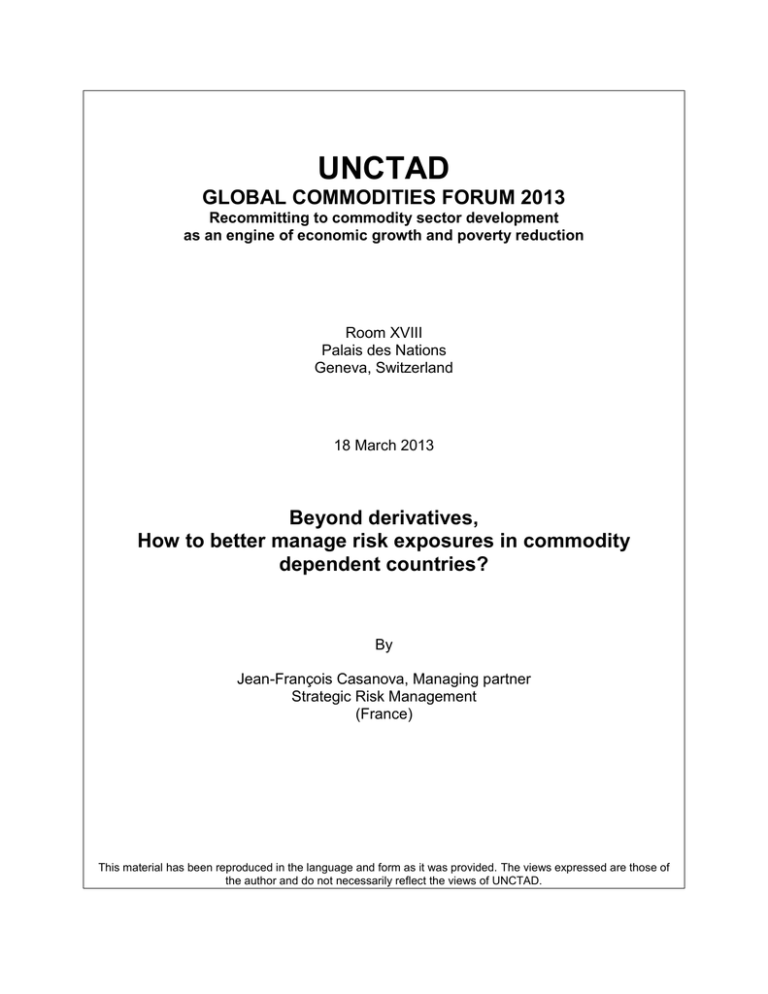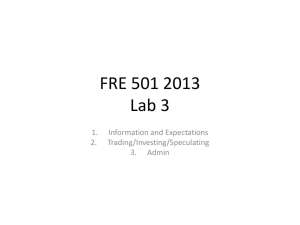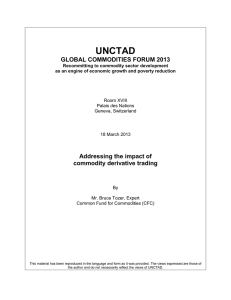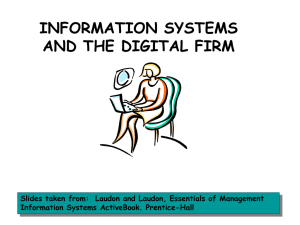UNCTAD
advertisement

UNCTAD GLOBAL COMMODITIES FORUM 2013 Recommitting to commodity sector development as an engine of economic growth and poverty reduction Room XVIII Palais des Nations Geneva, Switzerland 18 March 2013 Beyond derivatives, How to better manage risk exposures in commodity dependent countries? By Jean-François Casanova, Managing partner Strategic Risk Management (France) This material has been reproduced in the language and form as it was provided. The views expressed are those of the author and do not necessarily reflect the views of UNCTAD. Beyond derivatives, How to better manage risk exposures in commodity dependent countries? 18 – 19 March 2013 Risk Management is a managerial matter, not a trading decision • Major Private Commodity Companies are convinced that to maintain their leadership they will have to invest heavily in logistics infrastructures and industrial tools • These investments will be supported by organic growth operations but also by acquisitions • Their external growth seems to be the fastest and least risky vectors to optimize the risk‐return associated with the capture of new markets (both upstream and downstream) and the reduction of uncertainty of "Greenfield" projects • Commodity and energy market prices Volatility, Regulatory uncertainty and Credit risk concentrations appear as the three most significant risks of their business models • These risks are perceived as all the more important that they weigh a great deal in the expected volatility of their results and hence, in the financial terms and covenants of the financing they need to get from their banks and markets to finance their development 2 How leading commodity companies perceive and rank their risk exposures ? Source: Study carried out by Strategic Risk management during January 2013 3 How they deal with risk uncertainty to deliver reliability? Global Trading Commodity Company Commodity Traders Centralized Strategic Trading & Risk Management Commodity Processor Regional trading centers Large international Strategic Commodity purchasing network (local presence procedures & Risk Management in more than 30 countries) Local operations Regional trading centers Strategic sourcing alliance Large international network Commodity Producers (local presence in more than 30 More exporter than countries) traders Strategic sourcing alliance Often partly owned by producers and or processors Blurred responsibilities Delocalized Trading Companies Few written procedures (fully or partly owned) and systems Traders managed on Traders managed on performance (rarely weighted by risk) Traders have few incentive on global performance performance versus budget Risk management report to Top management Company relative size by Sales and numbers of « traders » Risk management report to Top management Matrix Organization Global presence in more than 50 countries Highly structured , clear written procedure and systems Global Trading center by Region & by Product Each trading desk is a profit center & acts with other desks as if they were external companies Trader managed through remuneration plan indexed on performance and capital use Risk management report to Top management 4 For Leading Commodity Companies, Food Unrests matter but are not a major issue concern 5 For Commodity‐Dependent Government or State owned Companies is different • The Mission of Government and, by delegation, of Commodity Boards and/or State owned Companies is to improve, years after years, the revenues of domestic commodity producers/processors. • Commodity dependent countries have specific characteristics such as: – They are naturally long of commodities on which they are price takers and not price maker – They are generally not diversified in their sources of revenues – They have very poor infrastructures (physical and financial) – They think locally and very rarely globally while commodity market are global and interconnected – They sell their products to Global traders, often with a lot of imbedded options in the contracts. • Understanding and managing risks for the long term is a key issue for improving local commodity producers/processors revenues 6 Stabilizing revenue is NOT ONLY getting a better price than the average annual market price • • • • • Clear view of your targets and of what it implies Access to funding for physical infrastructures (road, storage capacity…) A good understanding of commodities economics and interactions with production input and other commodities Access to financial market for educated traders with capacity to trade volatility through physical/future « basis » trade, maturity, quality and geographical arbitrage Strong risk management process and reporting Weather Risk INPUT Climate insurance Quan ty Risk Price Risk Commodity Exchanges Future and/or Op on Crop insurance Correla ons Price Quan ty Income support and stabiliza on programs Suppliers/Buyers Fixed or Formula price Credit Risk COOPS and/or Traders Price risk management Commodity Board Income stability Banks and Credit Risk Guarantees Access To Credit Disposal income Stability Investments stability 7 How to fund the transactional risks ? • Commodity Value Chain to Finance Pré production Investment • Commodity Finance & Risk Management Important funding needs, High perceived Risk, Tough funding Term Loans Inputs, Harvesting, Storage and Labor Annual Cycle Pré‐Financing Collateral Loans Borrowin g base Revolving credit facility 3 to 5 Y funding requires own funds/collateral Processing Investment and Working capital Marketing and Merchandizing Credit Risk Retail Reserve based lending 3 to 5 Y difficult to hedge 1 to 4 month Collateral and Acceptable balance sheet Low funding needs, Low perceived Risk, Easy Access to Funding Export Pre export finance Drawee Risk Line & Dirct pay LC Retail Export 8 How to smooth Long term revenues? • One way is to use derivatives to hedge, over a three years hedging program, the INPUT and the OUTPUT. Utilities in Europe are frequently using this type of technics for managing their margin (CSS) At January 1st2012: • 90% of 2012 was hedged • 50% of 2013 and • 20% of 2014 9 Provided you have the infrastructures and the people you can hedge but some constraints remain Market risk vs counterparty risk vs liquidity risk Hedging constraints - Market risk hedging policies should not be subject to any trade off with counterparty risk (as long as hedging is viable1) ) Higher Market Risk - Unless liquidity becomes an issue, counterparty risk should be mitigated, with Margining Agreements (CSA) if necessary or deals on organized markets unhedged position Hedging transforms market risk into counterparty risk 1 1' Neutral risk position hedged position Higher Counterparty risk Direct hedging on organized markets transforms market risk into cash risk hedged position with counterparty risk mitigation 2 CSA mitigates counterparty risk and generates cash risk Higher Liquidity Risk - Other counterparty risk mitigation tools should always be considered, in particular: selecting highly rated counterparties, ensuring diversification… - Liquidity vs. counterparty risk trade off should be regularly assessed and consolidated through an iterative process : a. Assess needs for additional desired collateralization applying an adequate stress scenario b. All liquidity needs have to be consolidated c. If the impact is acceptable, an ad hoc Risk Committee authorizes the implementation of the desired collateralization If not, the ad hoc Risk Committee has to make an arbitrage 1) e.g.: for countries with illiquid markets and a little number of low creditworthiness counterparties, hedging is not viable 10 Now let’s have a dream to protect producers revenue and make the environment safer and more reliable ? • • The programme largely inspired by Canadian programme could probably be funded X% by the International community (including NGO), Y% by Governments and Z% by Producers themselves It obviously implies Governance, accountability, accounting and infrastructures 1 three‐year, moving‐average net income taken out of the last 5years with the top and bottom years discarded STRATEGIC RISK MANAGEMENT 16, rue José‐Maria de Heredia, 75007 Paris +33 (0) 145.62.16.64. jcasanova@riskvalue.com www.riskvalue.com 12







